Middle East correspondent
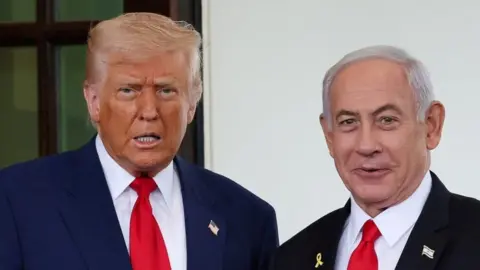 Reuters
ReutersAfter 21 months of war, there are growing hopes of a new Gaza ceasefire announcement as Israel’s Prime Minister Benjamin Netanyahu meets US President Donald Trump in Washington.
Trump previously told reporters he had been “very firm” with Netanyahu about ending the conflict and that he thought “we’ll have a deal” this week.
“We are working to achieve the deal that has been discussed, under the conditions we have agreed,” the veteran Israeli PM said before boarding his plane. “I believe that the conversation with President Trump can definitely help advance this outcome, which we all hope for.”
Indirect talks between Israel and Hamas on a US-sponsored proposal for a 60-day ceasefire and hostage release deal resumed in Qatar on Sunday evening.
However, it is unclear whether key differences that have consistently held up an agreement can be overcome.
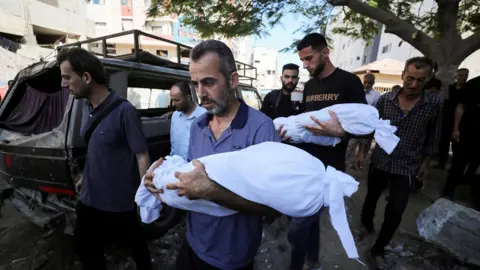 Reuters
ReutersOnly cautious optimism is being expressed by weary Palestinians living in dire conditions amid continuing daily Israeli bombardment, and the distressed families of Israeli hostages still held by Hamas.
“I don’t wish for a truce but a complete stop to all war. Frankly, I’m afraid that after 60 days the war would restart again,” says Nabil Abu Dayah, who fled from Beit Lahia in northern Gaza to Gaza City with his children and grandchildren.
“We got so tired of displacement, we got tired of thirst and hunger, from living in tents. When it comes to life’s necessities, we have zero.”
On Saturday evening, large rallies took place urging Israel’s government to seal a deal to return some 50 hostages from Gaza, up to 20 of whom are believed to be alive.
Some relatives questioned why the framework deal would not free all captives immediately.
“How does one survive under such conditions? I’m waiting for Evyatar to return and tell me himself,” said Ilay David, whose younger brother, a musician, was filmed by Hamas in torment as he watched fellow hostages being released earlier this year during the last, two-month-long ceasefire.
“This is the time to save lives. This is the time to rescue the bodies from the threat of disappearance,” Ilay told a crowd in Jerusalem.
“In the rapidly changing reality of the Middle East, this is the moment to sign a comprehensive agreement that will lead to the release of all the hostages, every single one, without exception.”
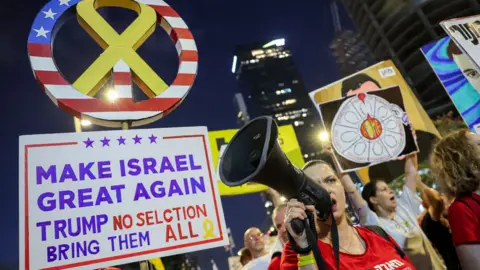 AFP
AFPNetanyahu is visiting the White House for the third time since Trump returned to power nearly six months ago.
But the leaders will be meeting for the first time since the US joined Israeli attacks on Iranian nuclear sites and then brokered a ceasefire between Israel and Iran.
There is a strong sense that the recent 12-day war has created more favourable circumstances to end the Gaza war.
After months of low popularity ratings, the Israeli PM has been bolstered by broad public support for the Iran offensive and analysts suggest he now has more leverage to agree to a peace deal over the strong objections of his far-right coalition partners, who want Israel to remain in control of Gaza.
Hamas is seen to have been further weakened by the strikes on Iran – a key regional patron – meaning it could also be more amenable to making concessions needed to reach an agreement.
Meanwhile, Trump is keen to move on to other priorities in the Middle East.
These include brokering border talks between Israel and Syria, returning to efforts to normalise relations between Israel and Saudi Arabia, and completing unfinished business with Iran, involving possible negotiations on a new nuclear deal.
For months, ceasefire talks between Israel and Hamas have been deadlocked over one fundamental difference.
Israel has been ready to commit to a temporary truce to return hostages but not an end to the war. Hamas has demanded a permanent cessation of hostilities in Gaza and a full pullout of Israeli troops.
The latest proposal put to Hamas is said to include guarantees of Washington’s commitment to the deal and to continued talks to reach a lasting ceasefire and the release of all the hostages.
Nothing has been officially announced, but according to media reports the framework would see Hamas hand over 28 hostages – 10 alive and 18 dead – in five stages over 60 days without the troubling handover ceremonies it staged in the last ceasefire.
There would be a large surge in humanitarian aid entering Gaza.
After the return of the first eight living hostages on the first day of the agreement, Israeli forces would withdraw from parts of the north. After one week, the army would leave parts of the south.
On Day 10, Hamas would outline which hostages remain alive and their condition, while Israel would give details about more than 2,000 Gazans arrested during the war who remain in “administrative detention” – a practice which allows the Israeli authorities to hold them without charge or trial.
As seen before, large numbers of Palestinians would be released from Israeli jails in exchange for hostages.
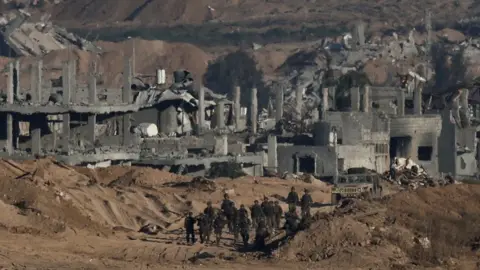 Reuters
ReutersPresident Trump has described this as the “final” truce proposal and said last week that Israel had accepted “the necessary conditions” to finalise it.
On Friday, Hamas said it had responded in a “positive spirit” but expressed some reservations.
A Palestinian official said sticking points remained over humanitarian aid – with Hamas demanding an immediate end to operations by the controversial Israeli and American-backed Gaza Humanitarian Foundation (GHF) and a return to the UN and its partners overseeing all relief efforts.
Hamas is also said to be questioning the timetable for Israeli troop withdrawals and operations of the Rafah crossing between southern Gaza and Egypt.
Netanyahu’s office stated on Saturday that the changes wanted by Hamas were “not acceptable” to Israel.
The prime minister has repeatedly said that Hamas must be disarmed, a demand the Islamist group has so far refused to discuss.
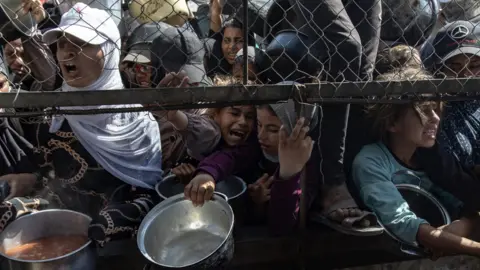 EPA
EPAIn Israel, there is growing opposition to the war in Gaza, with more than 20 soldiers killed in the past month, according to the military.
The Israeli military’s chief of staff, Lt Gen Eyal Zamir, said last week that it was nearing the completion of its war goals and signalled that the government must decide whether to move ahead with a deal to bring home hostages or prepare for Israeli forces to re-establish military rule in Gaza.
Polls indicate that two-thirds of Israelis support a ceasefire deal to bring home the hostages.
In Gaza, some residents express fears that the current wave of positivity is being manufactured to ease tensions during Netanyahu’s US trip – rationalising that this happened in May as Trump prepared to visit Arab Gulf states.
The coming days will be critical politically and in humanitarian terms.
The situation in Gaza has continued to deteriorate, with medical staff reporting acute malnutrition among children.
The UN says that with no fuel having entered in over four months, stockpiles are now virtually gone, threatening vital medical care, water supplies and telecommunications.
Israel launched its war in Gaza in retaliation for the Hamas-led attacks on 7 October 2023, which killed about 1,200 people and led to 251 others being taken hostage.
Israeli attacks have since killed more than 57,000 people in Gaza, according to the Hamas-run health ministry. The ministry’s figures are quoted by the UN and others as the most reliable source of statistics available on casualties.
